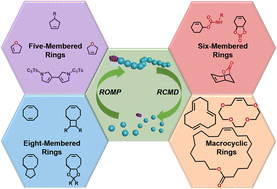Chemical recycling of polyolefins via ring-closing metathesis depolymerization
Abstract
The current insufficient recycling of commodity polymer waste has resulted in pressing environmental and human health issues in our modern society. In the quest for next-generation polymer materials, chemists have recently shifted their attention to the design of chemically recyclable polymers that can undergo depolymerization to regenerate monomers under mild conditions. During the past decade, ring-closing metathesis reactions have been demonstrated to be a robust approach for the depolymerization of polyolefins, producing low-strain cyclic alkene products which can be repolymerized back to new batches of polymers. In this review, we aim to highlight the recent advances in chemical recycling of polyolefins enabled by ring-closing metathesis depolymerization (RCMD). A library of depolymerizable polyolefins will be covered based on the ring size of their monomers or depolymerization products, including five-membered, six-membered, eight-membered, and macrocyclic rings. Moreover, current limitations, potential applications, and future opportunities of the RCMD approach will be discussed. It is clear from recent research in this field that RCMD represents a powerful strategy towards closed-loop chemical recycling of novel polyolefin materials.

- This article is part of the themed collection: 2023 Emerging Investigators


 Please wait while we load your content...
Please wait while we load your content...
